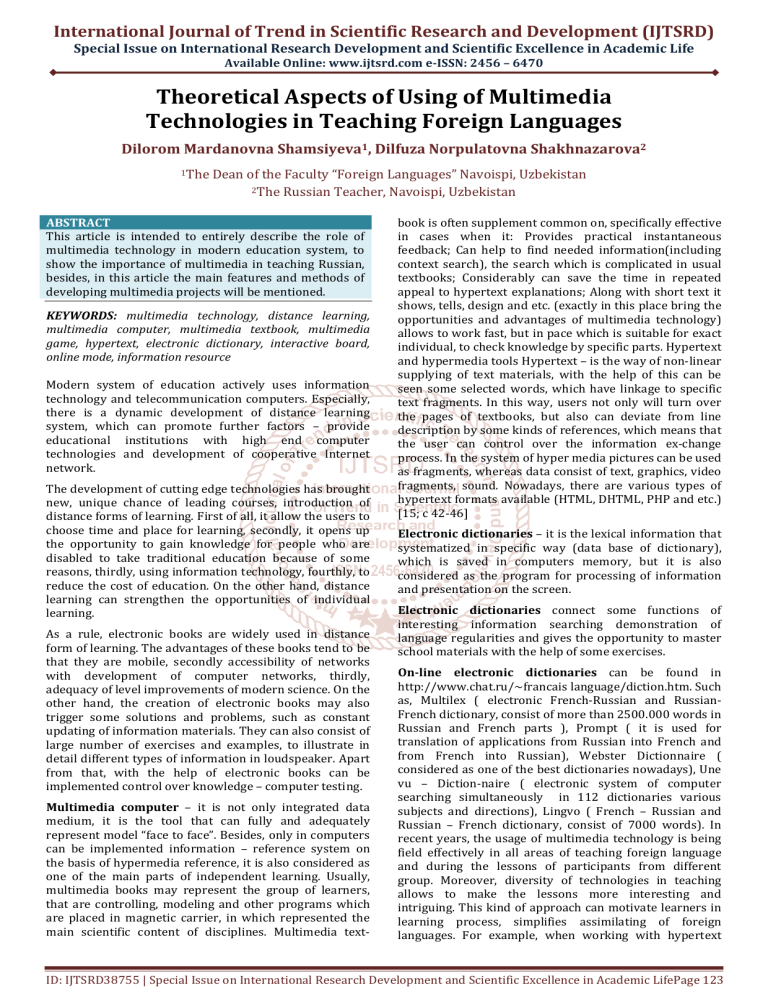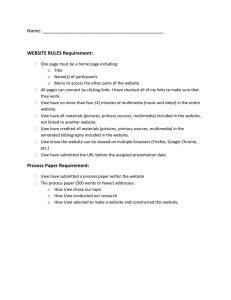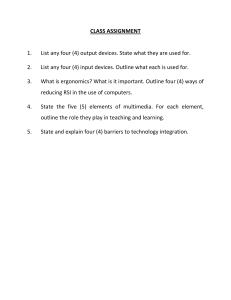
International Journal of Trend in Scientific Research and Development (IJTSRD)
Special Issue on International Research Development and Scientific Excellence in Academic Life
Available Online: www.ijtsrd.com e-ISSN: 2456 – 6470
Theoretical Aspects of Using of Multimedia
Technologies in Teaching Foreign Languages
Dilorom Mardanovna Shamsiyeva1, Dilfuza Norpulatovna Shakhnazarova2
1The
Dean of the Faculty “Foreign Languages” Navoispi, Uzbekistan
2The Russian Teacher, Navoispi, Uzbekistan
ABSTRACT
This article is intended to entirely describe the role of
multimedia technology in modern education system, to
show the importance of multimedia in teaching Russian,
besides, in this article the main features and methods of
developing multimedia projects will be mentioned.
KEYWORDS: multimedia technology, distance learning,
multimedia computer, multimedia textbook, multimedia
game, hypertext, electronic dictionary, interactive board,
online mode, information resource
Modern system of education actively uses information
technology and telecommunication computers. Especially,
there is a dynamic development of distance learning
system, which can promote further factors – provide
educational institutions with high end computer
technologies and development of cooperative Internet
network.
The development of cutting edge technologies has brought
new, unique chance of leading courses, introduction of
distance forms of learning. First of all, it allow the users to
choose time and place for learning, secondly, it opens up
the opportunity to gain knowledge for people who are
disabled to take traditional education because of some
reasons, thirdly, using information technology, fourthly, to
reduce the cost of education. On the other hand, distance
learning can strengthen the opportunities of individual
learning.
As a rule, electronic books are widely used in distance
form of learning. The advantages of these books tend to be
that they are mobile, secondly accessibility of networks
with development of computer networks, thirdly,
adequacy of level improvements of modern science. On the
other hand, the creation of electronic books may also
trigger some solutions and problems, such as constant
updating of information materials. They can also consist of
large number of exercises and examples, to illustrate in
detail different types of information in loudspeaker. Apart
from that, with the help of electronic books can be
implemented control over knowledge – computer testing.
Multimedia computer – it is not only integrated data
medium, it is the tool that can fully and adequately
represent model “face to face”. Besides, only in computers
can be implemented information – reference system on
the basis of hypermedia reference, it is also considered as
one of the main parts of independent learning. Usually,
multimedia books may represent the group of learners,
that are controlling, modeling and other programs which
are placed in magnetic carrier, in which represented the
main scientific content of disciplines. Multimedia text-
book is often supplement common on, specifically effective
in cases when it: Provides practical instantaneous
feedback; Can help to find needed information(including
context search), the search which is complicated in usual
textbooks; Considerably can save the time in repeated
appeal to hypertext explanations; Along with short text it
shows, tells, design and etc. (exactly in this place bring the
opportunities and advantages of multimedia technology)
allows to work fast, but in pace which is suitable for exact
individual, to check knowledge by specific parts. Hypertext
and hypermedia tools Hypertext – is the way of non-linear
supplying of text materials, with the help of this can be
seen some selected words, which have linkage to specific
text fragments. In this way, users not only will turn over
the pages of textbooks, but also can deviate from line
description by some kinds of references, which means that
the user can control over the information ex-change
process. In the system of hyper media pictures can be used
as fragments, whereas data consist of text, graphics, video
fragments, sound. Nowadays, there are various types of
hypertext formats available (HTML, DHTML, PHP and etc.)
[15; c 42-46]
Electronic dictionaries – it is the lexical information that
systematized in specific way (data base of dictionary),
which is saved in computers memory, but it is also
considered as the program for processing of information
and presentation on the screen.
Electronic dictionaries connect some functions of
interesting information searching demonstration of
language regularities and gives the opportunity to master
school materials with the help of some exercises.
On-line electronic dictionaries can be found in
http://www.chat.ru/~francais language/diction.htm. Such
as, Multilex ( electronic French-Russian and RussianFrench dictionary, consist of more than 2500.000 words in
Russian and French parts ), Prompt ( it is used for
translation of applications from Russian into French and
from French into Russian), Webster Dictionnaire (
considered as one of the best dictionaries nowadays), Une
vu – Diction-naire ( electronic system of computer
searching simultaneously in 112 dictionaries various
subjects and directions), Lingvo ( French – Russian and
Russian – French dictionary, consist of 7000 words). In
recent years, the usage of multimedia technology is being
field effectively in all areas of teaching foreign language
and during the lessons of participants from different
group. Moreover, diversity of technologies in teaching
allows to make the lessons more interesting and
intriguing. This kind of approach can motivate learners in
learning process, simplifies assimilating of foreign
languages. For example, when working with hypertext
ID: IJTSRD38755 | Special Issue on International Research Development and Scientific Excellence in Academic LifePage 123
International Journal of Trend in Scientific Research and Development (IJTSRD) @ www.ijtsrd.com eISSN: 2456-6470
learners not only turn over the page of textbook, but also
can affect from line description by some references which
means they themselves can control the process of
information exchange.
Interactive board: The usage of projection technologies in
combination of audio tools gives the chance of attract
students in the lessons when explaining new resources
theses, tables, videos and reference materials, when
analyzing texts – schemes and the information of
electronic dictionaries. It gives the opportunity to carry
out visual aids, availability and systemic description of
materials.
In context of the above truly revolutionary invention is
considered to be interactive SMART Board. By using this
kind of board, teacher can combine proved methods and
the style of working with common board with the set of
interactive and multimedia opportunities.
Electronic board SMART allows: Active commenting upon
materials: highlighting,
definition, adding extra
information by means of electronic markers with the
possibility of changing color and thickness of lines. Full –
fledged translation in terms of text translation and
separated sentences with stated connection and
interrelations between words; With means of virtual
keyboards any kinds of text tasks in any applications and
its demonstration in the mode of real time. Not only
familiarity with test tasks in browsing mode, but also
demonstrative testing of separated books or groups of
students for all classroom, In schools computer classes
absent or they are not available for teacher use for the
moment; Saving of results in various separated file in the
form of pictures or in HTML and PDF-formats.
It should be signified that interactive board has positively
impact on teaching foreign languages, as it is considered to
be overt illustration of untraditional approach of teaching
foreign languages. Teachers of a foreign language who
have sufficient experience with an interactive whiteboard
have identified for themselves its undoubted advantages:
working with the board allows you to fully implement
the principle of clarity;
bright and attractive materials of the collection raise
aesthetic taste in children;
interactive board capabilities allow you to remove
difficulties in the process of monologic utterance;
The ability to cut and erase objects from the screen,
copy and paste them, cancel or return actions gives
students more confidence: they know that they can
always go back a step, change or correct something.
Concisely, Interactive whiteboard features allowance for
students to understand that video and game programs are
successfully used for learning, contributing to the
development of creative activity, fascination with the
subject, and creating the best conditions for mastering
listening and speaking skills, which ultimately ensures the
efficiency of learning in foreign language lessons .
References:
[1] Richards, J. C. (2001). The context of language
teaching. Beijing: Foreign Languages Teaching and
Research Press
[2]
Ellis, R. (1999). Understanding second language
acquisition. Shanghai: Shanghai Foreign Language
Education Press.
[3]
web.uri.edu
ID: IJTSRD38755 | Special Issue on International Research Development and Scientific Excellence in Academic LifePage 124



